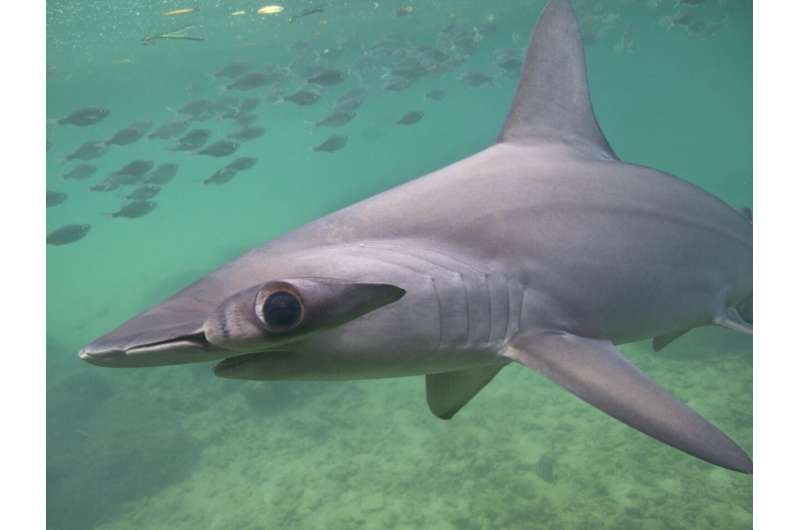Shark may avoid cold blood by holding its breath on deep dives

Scalloped hammerhead sharks stay warm as they descend into cold, deep water off the coast of Hawaii, suggesting the cold-blooded species may maintain its body temperature on dives by holding its breath, according to new research presented at the Ocean Sciences Meeting 2020 in San Diego, California.
The new results are surprising because typically, hammerhead sharks quickly assimilate the temperature of the surrounding water. The sharks are not known to have physiological means to retain or generate heat internally, according to Mark Royer, a marine biologist at the University of Hawaii Manoa, who will present the new research on Thursday, February 20.
Royer tracked scalloped hammerhead sharks making frequent, short trips 800 meters below the surface.
Water off the coast of Hawaii drops from a comfortable 25 degrees Celsius (75 degrees Fahrenheit) at the surface to temperatures closer to the inside of a refrigerator, about 4 degrees Celsius (40 degrees Fahrenheit), at 800 meters (2,600 feet) below the surface.
Royer suspects the hammerheads are modulating their behavior to keep their muscles warm enough for active hunting at depth.
"Hammerheads are a tropical and warm temperate species. When their body temperature gets too low, they lose muscle function, visual acuity, and their metabolism slows down. If a shark gets too cold, it can't keep itself moving and breathe," Royer said.
Sharks breathe by pulling oxygen into their blood from ocean water as it rushes into their mouths and out through their gill slits. They have to keep moving forward to avoid drowning. Water contact over the large surface of their gills also quickly cools or warms their blood to the temperature of the water.
Royer thinks the scalloped hammerhead sharks may be simply shutting their mouths, or clamping their gills shut, on dives to keep out the water and avoid getting chilled.
"The laws of thermodynamics hold," Royer said. "We know the water is super cold and the sharks are staying warm. So the sharks can't be dumping body heat out through their gills."
Some warm-blooded fish species, like bluefin tuna and great white sharks, have specialized muscle in core of their bodies that rewarms their blood and allows them to hunt in colder water. The hammerheads do not have analogous anatomy, although Royer said it is possible they have a previously unknown ability to divert blood away from their gills.
"We don't know what the mechanism is, whether it's simply closing their mouths and closing their gills, or if they're shunting the blood away from their gills. Either one of those mechanisms means there is no longer gas exchange at the gills, so the shark is basically holding its breath in a way that a shark can while it's conducting these deep dives," Royer said.
Royer tagged hammerheads with a package of sensors that recorded the sharks' depth, tailbeats, and the pitch and roll of their bodies, as well as the temperature of their muscle and that of the surrounding water, following them from Kāneʻohe Bay, in the island of Oahu, as they made repeated dives of off the coast to depths over 800 meters (2,600 feet). He followed nine sharks for 7 to 23 days, gathering over 1,750 hours of data.
During dives, the sharks cruised leisurely down to about 100 meters (330 feet). Then their noses pitched down 80 degrees and they sprinted to the depths.
"They're almost like a dive-bombers," Royer said.
Body temperatures held constant past 150 meters (500 feet) depth, where researchers would expect to observe the sharks beginning to cool down, and as the sharks swam vigorously at depth. After about five minutes, the sharks dashed back up to about 300 meters (1,000 feet), where they slowed down, and their body temperatures abruptly dropped.
The sharks spent roughly 45 minutes at the surface, as their bodies slowly warmed, before repeating the dive cycle.
Researchers aren't certain what the sharks are doing on their dives, but occasional discoveries of deep sea squid beaks in hammerhead stomachs suggests the sharks are hunting prey that live in deep water. Royer plans to include cameras in future work, to learn more about what the sharks are doing on their dives and observe their mouths and gills.
Provided by American Geophysical Union
This story is republished courtesy of AGU Blogs (http://blogs.agu.org), a community of Earth and space science blogs, hosted by the American Geophysical Union. Read the original story here.




















